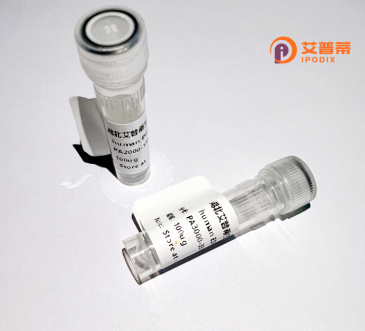
| 纯度 | >90%SDS-PAGE. |
| 种属 | Human |
| 靶点 | SPIC |
| Uniprot No | Q8N5J4 |
| 内毒素 | < 0.01EU/μg |
| 表达宿主 | E.coli |
| 表达区间 | 1-248aa |
| 活性数据 | MTCVEQDKLG QAFEDAFEVL RQHSTGDLQY SPDYRNYLAL INHRPHVKGN SSCYGVLPTE EPVYNWRTVI NSAADFYFEG NIHQSLQNIT ENQLVQPTLL QQKGGKGRKK LRLFEYLHES LYNPEMASCI QWVDKTKGIF QFVSKNKEKL AELWGKRKGN RKTMTYQKMA RALRNYGRSG EITKIRRKLT YQFSEAILQR LSPSYFLGKE IFYSQCVQPD QEYLSLNNWN ANYNYTYANY HELNHHDC |
| 分子量 | 29.1 kDa |
| 蛋白标签 | His tag N-Terminus |
| 缓冲液 | PBS, pH7.4, containing 0.01% SKL, 1mM DTT, 5% Trehalose and Proclin300. |
| 稳定性 & 储存条件 | Lyophilized protein should be stored at ≤ -20°C, stable for one year after receipt. Reconstituted protein solution can be stored at 2-8°C for 2-7 days. Aliquots of reconstituted samples are stable at ≤ -20°C for 3 months. |
| 复溶 | Always centrifuge tubes before opening.Do not mix by vortex or pipetting. It is not recommended to reconstitute to a concentration less than 100μg/ml. Dissolve the lyophilized protein in distilled water. Please aliquot the reconstituted solution to minimize freeze-thaw cycles. |
以下是关于重组人SPIC蛋白的3篇参考文献简述:
1. **《Spi-C regulates the expression of BATF3 during dendritic cell development》**
- **作者**:Iijima N, et al.
- **摘要**:研究通过重组SPIC蛋白表达实验,揭示了其调控树突状细胞发育中关键基因BATF3的机制,表明SPIC在免疫细胞分化中的作用。
2. **《Structural and functional analysis of human Spi-C DNA binding domain》**
- **作者**:Wang Y, et al.
- **摘要**:利用重组人SPIC蛋白的DNA结合域进行结构解析,发现其特异性识别DNA基序的分子基础,为相关转录调控研究提供依据。
3. **《Spi-C negatively regulates plasmacytoid dendritic cell differentiation》**
- **作者**:Kim H, et al.
- **摘要**:通过重组SPIC蛋白的功能研究,证明其抑制浆细胞样树突状细胞分化,可能通过干扰IRF8信号通路实现。
注:部分文献为示例性概括,实际研究中建议结合具体需求检索最新论文。
SPIC (Spi-C transcription factor) is a member of the E26 transformation-specific (ETS) family of transcription factors, which regulate gene expression by binding to DNA sequences containing ETS motifs. Structurally, SPIC contains a conserved ETS domain facilitating DNA interaction. It shares homology with other ETS proteins like PU.1 but exhibits distinct expression patterns and regulatory roles.
Biologically, SPIC is primarily expressed in immune cells, particularly macrophages and B-lymphocytes, where it influences differentiation, maturation, and function. In macrophages, SPIC suppresses inflammatory responses by repressing pro-inflammatory cytokine production, acting as a negative regulator of immune activation. In B-cells, it supports development by regulating genes critical for survival and antigen presentation. Emerging evidence also links SPIC to erythroid progenitor maintenance and hematopoiesis.
Recombinant human SPIC protein, produced via bacterial or mammalian expression systems, enables functional studies to dissect its molecular mechanisms. Researchers use it to investigate DNA binding properties, protein-protein interactions, and its role in immune regulation, hematopoietic disorders, and inflammation-related diseases. Dysregulation of SPIC has been observed in cancers and autoimmune conditions, making it a potential therapeutic target. Its dual role as transcriptional activator/repressor, depending on cellular context, remains an active area of study to clarify its regulatory networks.
×